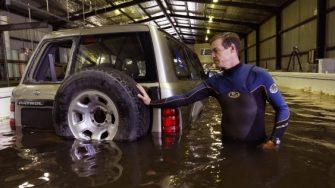"If it’s flooded, forget it”
The unforgettable findings from UNSW’s Water Research Laboratory that continue to inspire safety initiatives across Australia
The unforgettable findings from UNSW’s Water Research Laboratory that continue to inspire safety initiatives across Australia

In 2016, researchers at UNSW’s Water Research Laboratory (WRL) conducted world-first tests to demonstrate how easily cars can be washed away by the smallest currents. Almost a decade later, their findings are still being used to save lives and educate Australians on the dangers of driving through floodwaters.
Using a real-scale test tank, the research team, led by then-principal engineer Grantley Smith, were surprised by just how little water it took to make even a large vehicle unstable.
A small car, like a Toyota Yaris weighing 1.05 tonnes, was moved by water only 15cm deep and with a flow speed of just 3.6km/h. In 60cm of water it completely floats away.
A 2.5 tonne Nissan Patrol 4WD can be rendered unstable by floodwater 45cm high at a similar flow speed. At 95cm, the four-wheel drive completely floats and needs almost no force to move it by hand.
Previous experiments to understand the force of floodwaters had relied on using vehicle miniatures, rather than actual cars.
By using real cars, the team were able to accurately demonstrate how cars behave in flood waters and record video footage that remains a constant source of interest, and has since been repurposed for education, awareness and safety campaigns.
In April, the Queensland Government launched their “If It’s Flooded, Forget It” campaign, using the research and footage from the WRL’s testing.
Insights from the research were also featured in Craig Reucassel’s documentary Big Weather (And How to Survive it) (2020) on the ABC, and in 2019, Victoria State Emergency Services (VSES) highlighted the research for their “15 to Float” campaign, filming their advertisement in the WRL centre in Manly Vale.
Australia is facing an increased risk of flooding as the climate crisis worsens. The Australian Climate Service warns of an increased likelihood of extreme rainfall, coastal flooding, and flash flooding as the climate warms.
Toby Tucker, the current Principal Engineering at WRL who also worked on the project, is proud his team’s findings have had such lasting impact.
He says, “it’s great to see that the work has such a longevity and relevance. It was always a cool project, but I don’t think I would have foreseen the continued interest when we started.”
“As an engineer working in this field, you’re literally saving people’s lives. It’s really rewarding.”
However, Tucker also recognises that there is still a need for more awareness campaigns to help Australians better understand flood safety and make the life-saving choice to keep away from floodwaters.
“I still see people driving through floods – even on my own street which recently flooded – and I still wish I could do more. How do you keep up the education and keep the awareness out there so more people can be safe from this situation?”
Toby Tucker transcript:
As an engineer working in this field, you’re literally saving people’s lives, so it’s really rewarding to do this kind of work. Often we’re in this technical land doing quite complex work – so to see it translate to real life is cool. In the industry, I’ve been chatting with mates who are flood engineers and it’s really cool because day-to-day they are planning flood routes and this work is really relevant to them. But also in terms of looking after the public it’s cool to see that the work we are doing has a tangible impact. Help people understand the risks associated with floodwaters and hopefully keep them safe in the long run.
It was always a cool project (to start). One of the difficulties is this type of research can be expensive and is not always easy to do. My predecessors who were leading the project at the time – props to them for getting the funds to put work like this together because it is important. And seeing that it’s had a lasting impact now – 2017 – seven years on and we’re still chatting to people about cars floating and the risks associated with that. We’re still talking to people about how to stay safe in floodwaters. It’s great to see that the work has such a longevity and lifespan and relevance and lasting impact. I don’t think I would have foreseen that at the time. Seeing the continued interest.
But on the flip side, I still see people driving through floods – even my street recently flooded – and you just think "I wish I could still do more though”. How do you keep it going? How do you keep the education and awareness out there so people can be safe from this situation?
The next stage – the SES have been in touch in recent years because they often have to drive into floodwaters to rescue people, so understanding how their bigger trucks... can we expand the research to help them manage those risks as well.
As Australia’s best engineering faculty turns 75, there are just as many reasons why we’ve earned that title. Discover new stories weekly, celebrating the successes that have enabled progress for all.